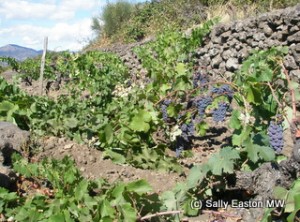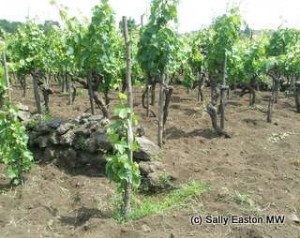The Etna crescent

Lava stone terraces on Etna
Mount Etna is a rather unique place in Sicily’s, let alone Italy’s viticultural heritage. Often referred to as an island within an island, its grape varieties are indigenous, its rainfall is prodigious, (relatively, around 1,000mm), and it’s an active volcano, the highest volcano in Europe, peaking at 3,323 metres.
Sicily’s reputation is as a hot, sun-drenched island, with wall-to-wall beaches, dripping with the sweetest blood-red oranges, island bang in the middle of the Mediterranean Sea. All this is true, but while the grape harvest starts at the western end of Sicily at the beginning of August (normal for the hot Mediterranean), picking may still be happening on Etna at the beginning of November. And Etna itself is far from uniform: harvest in the south end of the volcano may finish up to month before the north end.
The approximately 3,000 hectares of vineyards lie in a semi-circle on the north, east and south-facing slopes of the volcano from around 450m to 1,100m above sea level. At higher altitudes, high diurnal temperature variation helps preserves aroma and acidity in the fruit. The western slopes, with the long afternoon sun, favour the specialty production of pistachios around Bronte.
Nerello mascalese is the main red grape variety, with about 4,000 ha planted in the whole of Sicily, though the variety is indigenous to the volcano. Nerello cappuccio (no ‘n’ in there anywhere), which is reportedly named after the monks, plays a supporting role, with 800ha. The DOC Etna Rosso must be a minimum of 80% nerello mascalese with nerello cappuccio the remainder.
The white grape attracting attention is carricante, which prefers a higher altitude to keep its acidity and freshness. Carricante doesn’t feature in the top varieties’ list, so there are less than 750ha on the island. Etna Bianco must be minimum 60% carricante, with the remainder from the much less distinguished catarratto.
Benanti is the famous name on Mount Etna, located in the village of Viagrande, on the south east edge of the Etna crescent. They started growing grapes on Etna in the 1800s, and had a bit of a hiatus until 1988 when Giuseppe Benanti started growing grapes again on one of his father’s old farms. In this warmer southern spot, the sea is only about five kilometres distant.
Another long timer is large producer Nicosia, based in the neighbouring village of Trecastagni. They set up shop in 1898, and as do Benanti, these guys produce wines from a number of Sicilian regions.

Black volcanic soils
Other growers have arrived much more recently. Another famous Sicilian name, Planeta, bought 10 hectares (ha) of northern slopes at 870m above sea levels, in 2006. The north east aspect faces away from the heat of the midday Mediterranean sun, which adds a bit of cooling influence, along with the altitude. Planeta’s first release was 2009.
In 2007, Silvia Maestrelli and Federico Curtaz arrived to Tenuta di Fessina, at Rovitello, on the north side of Etna, and are already making impressive wines. They own 10 hectares of old, traditional bush vines which used to be owned by 11 people. The reds, nerello mascalese and nerello cappuccio face that favoured north east. “They’re similar to nebbiolo” said Curtaz, who still lives in Piedmont, and used to be the vineyard manager for Gaia, “with high acidity, and which need a long maturation.”
The pair’s carricante is around 1,000m, which they pick in late October or early November, with modest potential alcohol.
Another year later, and the first vintage of Tasca d’Almerita’s Tenuta Tascante (Tasca merged with a backwards Etna) estate on the northern slopes of Etna near Randazzo was 2008. Guiseppe Tasca said it is a work in progress as they are new to nerello mascalese and to the growing conditions on Etna. He added “we have two vineyards, 1km apart, which we put together [in the wine]. Maybe in the future when we have a winery there we will make two single vineyard wines.“ And because they don’t yet have a winery on Etna, their wine has to be labelled as an IGT Sicilia. Just one of those regulatory quirks.
Tasting, and wine notes, in situ, June 2011
Nicosia, Fondo Filara 2010, Etna Bianco
60% carricante, 40% catarratto. 13%. A third aged in second fill acacia for a month.
Almond and apple nose, fresh, very clean, with a bit of depth on the mid palate. Smooth texture, some honeysuckle fragrance, good intensity of fruit, with decent length. Will be good value, straight down the line Etna Bianco.
Tenuta di Fessina, Erse 2009, Etna Rosso ~€16
Nerello mascalese 13.5%
Pale colour, strawberries initially, with hints of stick liquorice and nutmeg spice. Nicely balanced, with a fresh core and supple fruit shown to the fore without with influence of oak. Good.,
Tenuta di Fessina, Etna Rosso 2008
Perfumed, aromatic and floral, with fresh, crunchy fruit, of discernibly intense fruit concentration. Medium deep body, with attractive line and form. Hints of liquorice stick, in a well balanced whole. Very good.
Tenuta di Fessina, Laeneo Nerello Cappuccio 2009 IGT Sicilia, ~ €13
The cappuccio vineyard is close to the carricante vineyard, at around 1,000m. Curtaz said “it is a curiosity, we make 2,000 bottles to see what nerello cappuccio could give to the blend.”
Medium pale, juicy red fruit nose, sweet attack, fresh and straight lined. Youthful, juicy. Think Chinon.
Tenuta di Fessina, Apuddara 2009, Etna Bianco ~€30
Vineyards face south at 1,000m. Carricante. Oak fermentation and maturation in big casks.
Curtaz: “it could stay in bottle 15 years. The acidity is around 7g/l. It’s a wine that searches for the centre of Europe, not the south. We pick cool grapes in late October, early November.”
Fresh, leesy nose, with Chablis-like mealiness on palate, though this has more fullness and roundness. Quite full, in a lush- fresh form, and sophisticated. Long mealy, citrus finish. Very good.
Tenuta di Fessina, Il Musmeci 2007, Etna Rosso ~€40
Named after the surname of the family who formerly owned the vineyards. Traditional field blend of nerello mascalese, up to 90%, and nerello cappuccio. 14%. Best grape selection; fermentation in stainless steel, following by 14-15 months in 500-litre and 35hl casks, bottled after around two years.
Pale colour. Aromatic, wafting smoke nose, almost full bodied, fresh core of sweet, baked red forest fruits, with strawberries and raspberries, and soft, fine-grained tannins. Also good.
Az. Vinicola Benanti, Pietramarina 2007, Etna Bianco Superiore
Stainless steel only. 12.5%. 950m asl. Carricante 100%. Harvest latter half October.
Steely nose, creamy palate, weighty and becoming nutty, with lots lees flavours and noticeable warmth despite 12.5%. Richly textured with savoury palate, intense, serious and long.
Az. Vinicola Benanti, Serra della Contessa 2006, Etna Rosso
Grown on Monte Serra, in commune of Viagrande, at lowest altitude of eastern side of Etna. Harvest end September. 14%. 450m asl. 80% mascalese; 20% cappuccio. 18 months in oak.
Medium deep colour; spicy, with hints of aromatic tar, quite rich and full, black berry fruit. Quite muscular, with still chewy tannins, and well balanced.
Az. Vinicola Benanti, Rovittello 2005, Etna Rosso
Nerello mascalese, nerello cappuccio. 14%. 750m asl, from the north, in commune of Castiglione di Sicilia. Harvest second half October. Stainless steel fermentation; one year in French barrique. First vintage of this wine in 1991.
Bright black cherry nose and palate attack, savoury aromatic tar, smooth and fresh. Linear, youthful and elegant, all in an attractive frame. Very good.
Az. Vinicola Benanti, Il Monovitigno, Nerello Cappuccio 2005, IGT Sicilia
Grown around Verzella, towards north, commune of Castiglione di Sicilia. 700m asl. Eight months in barrique for 8-10 months.
Black and aromatically tarry, dark and brooding, (might be quite dominant in a blend?) Savoury and dark with grainy texture.
Az. Vinicola Benanti, Il Monovitigno, Nerello mascalese IGT, 2005
Grown around Guardiola, towards north, commune of Castiglione di Sicilia. 750m asl. Stainless steel fermentation then age in barrel.
Perfume, fragrant, red berry fruits and blossom. Sweet and intoxicating heady nose. Smooth, bright red berries, sweet fruit, fresh acidity of backbone, lovely.
My research visit to Sicily in June 2011 was sponsored by the Sicilian Regional Institute for Viticulture and Wine.



